Everything You Need to Know About This Friday’s Close Shave by Asteroid 2012 DA14
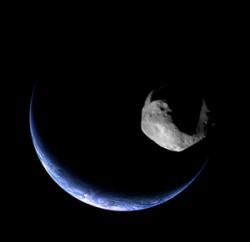
Image credits: Earth: ESA/Rosetta; asteroid Mathilde: NASA/NEAR
On Friday, Feb. 15, the Earth is going to get a very close shave by an asteroid*. Called 2012 DA14, this 50 meter (160 foot) rock will pass just over 27,000 kilometers (17,000 miles) from the Earth’s surface. This is closer than our geosynchronous satellites, so this really is a close pass!
But, to be very clear: This asteroid poses no threat to us right now, nor in the foreseeable future. Friday’s miss is just that: a miss. And, in fact, this is a good thing, since any time an asteroid gets close (but misses), we learn a lot, including how to find them, how to track them, and even how to talk about them to the public.
So let me tell you all about this little rock, and why it’s so cool.
TL;DR
For the “too long; didn’t read” crowd, I did a two-minute segment for the new science news web series This Week in Science and Technology (TWIST) with my friend Dr. Carin Bondar (my part starts 1m53s in):
Those are the basics, but if you want the really fun stuff, read on.
Pebble in the Sky
2012 DA14 was discovered in February 2012 by astronomers at the Observatorio Astronómico de La Sagra; it passed the Earth on Feb. 16th of that year, missing us by a comfortable 2.6 million km (1.6 million miles). The asteroid has a very Earth-like orbit, talking 366 days to orbit the Sun. Its orbit is slightly more elliptical than ours and tilted by about 11° to ours as well. All that’s about to change though: After the encounter this year, the Earth’s gravity will change the orbit of DA14 quite a bit, reducing the period to about 317 days.
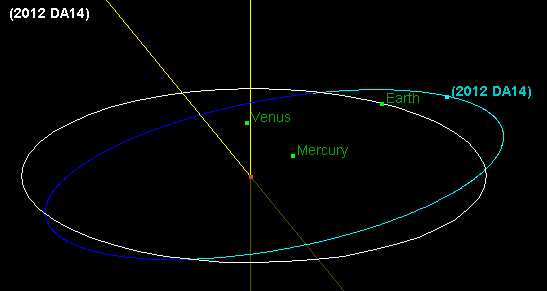
Image credit: NASA/JPL
Asteroids fall into various classes depending on their orbits; Apollo asteroids, for example, have a semi-major axis (the radius of their orbit measured across the long part of the ellipse) greater than Earth’s, and Atens have semi-major axes smaller than Earth’s. Right now, DA14 is an Apollo, but after the 15th its orbit will change shape so much it will become an Aten.
The exact shape of its orbit after this weekend’s event isn’t known, but we do know it well enough to rule out any potential impact for quite some time; the next encounter won’t be until 2046, and even then it won’t get closer than about 1.6 million km (1 million miles).
How Close a Miss Is This?
DA14 will slip past at a distance of 27,000 kilometers from the Earth’s surface. The Earth itself is about 13,000 km across, so the asteroid will be twice our own diameter away. That may be hard to picture in your head, so here’s a diagram:
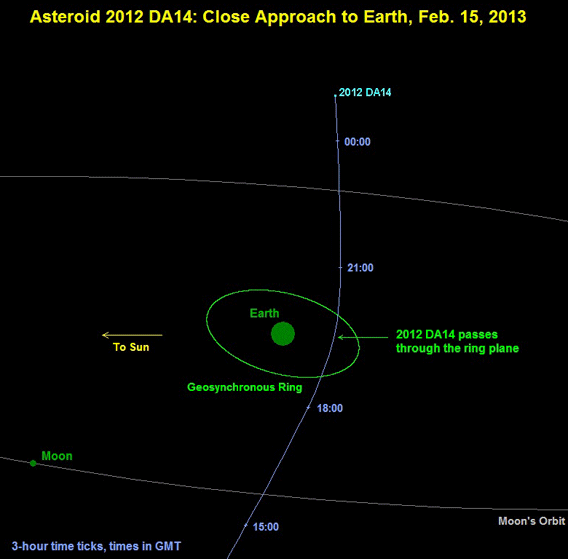
Image credit: NASA/JPL
This drawing, made by scientists at NASA/JPL, is to scale (the asteroid itself would be far, far smaller than a pixel on this scale; the Earth is over 100,000 times wider than DA14). You can see the Earth in the center as the green disk, the path of DA14, the circle where geosynchronous satellites orbit (about 36,000 km/22,000 miles above the Earth’s surface), and the Moon’s orbit. In the diagram, our viewpoint is above the plane of the orbits of the satellites and Moon, so we see them as ellipses. DA14 approaches from “below” and moves up, out of the plane of Earth’s orbit.
The pass happens over the Earth’s night side (the Sun is off to the left in the diagram), which is an advantage for folks there; if it happened on the daylit side this would be far harder to observe. The time of passage, around 19:30 UTC, means that the folks in Eastern Europe, Asia, and Australia get the best view. In the United States, we’ll see it best after closest approach, just after sunset.
This miss was predicted last year, not long after the asteroid’s discovery. NASA/JPL put together a nice informative video on the asteroid; at the 37 second mark you can see the encounter from DA14’s point of view:
But excluding actual impacts, 2012 DA14 will be still only be the eighth-closest approach by a known asteroid on record. The closest on record without actually hitting us was 2011 CQ1, which, in 2011, passed us by about 5500 km (3300 miles)—less than Earth’s radius! It was only about a meter across, so even if it had hit us we would’ve gotten a spectacular fireball, but probably no actual damage.
However, this is the largest asteroid we’ve seen come this close. Even then, it’s only 50 meters across, which is small as asteroids go.
So, Can I See It?
Even though it’s passing pretty close, DA14 is so small that it never gets bright enough to see with the unaided eye. I’ve seen predictions that it will get to about magnitude 7, which is less than half as bright as the faintest thing you can see. However, that’s well within range of binoculars or a small telescope.
I’ll note that this is not the closest we’ve ever seen an asteroid get (I’ve seen a few sites reporting it that way). For one thing, in 2008, the small asteroid 2008 TC3 hit us. It was only a meter across, and was detected only a day before impact—it burned up over Sudan in Africa. An expedition recovered meteorites from it, and I got to hold one in my hand. That was an amazing feeling.
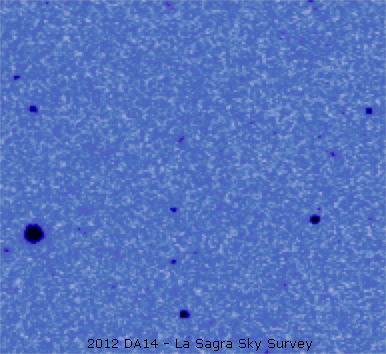
[Asteroid 2012 DA14 as seen by the La Sagra observatory in 2012. Credit: La Sagra/ESA]
For rough positions, Heavens Above has a page showing the asteroid’s position in the sky over time.
If you have some experience observing using astronomical coordinates, you can generate an ephemeris (positions over time) for the asteroid at the IAU Minor Planet page. If not, you can try to find out if any local astronomy clubs or observatories are observing it.
I imagine there will be several observatories watching this event live, and will post images and video online. As of the time of this writing I only know of one: The Clay Observatory in Brookline, Massachusetts will have a live video stream when DA14 becomes visible to them, shortly after sunset on the 15th. They have a page with more info, too.
I’ll update this post as I learn of more places to watch online. If it’s clear, I might take a shot at observing it myself, though from my location it’ll already have faded substantially by the time the Sun sets.
How Often Does This Sort of Thing Happen?
Again, this asteroid will miss us, so we’re safe. But it’s not the only asteroid out there! How often does one this size pass us?
On average, a 50 meter asteroid passes this close every 40 years or so. It’s random, so the next one could be next week, or not for 100 years. That’s just an average over a long period of time.
Mind you, the Earth gets hit by roughly 100 tons of material every day! It’s usually countless bits of debris the size of a grain of sand or smaller, though. The bigger the object, the more rare it is.
As of right now, only six close approaches of various asteroids are known for the next year, but that number will no doubt increase as time goes on; most asteroids discovered are small and only discovered when they’re close by.
And while close approaches aren’t hugely common, an actual impact by something 50 meters across is even more rare occurring on average less than once per millennium. That’s a good thing, because such an impact would—not to get too technical—suck.
So It Won’t Hit. But What If It Did?
Ah, you’re one of those people who enjoys scaring the crap out of yourself. OK, let’s think about what would happen if DA14’s path actually did intersect ours.
We have some decent comparisons. There is a crater in Arizona called, oddly enough, Meteor Crater, that’s about 1.2 kilometers (0.75 miles) across. It was created 50,000 years ago or so by an asteroid roughly the size of DA14, which upon impact probably detonated with an explosion equivalent to a 20 megaton nuclear weapon going off.
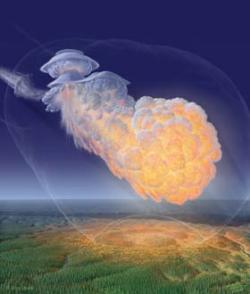
Image credit: Don Davis, used by permission.
That asteroid was metallic, so it could make it through the Earth’s atmosphere and hit the ground. We now know many asteroids are much less sturdy, and probably would explode high in the atmosphere, disintegrating under the excruciating pressures of screaming through the air at Mach 20. That happened in Siberia in 1908 in the famous Tunguska event. Again, a DA14-sized rock came in, but this time blew up high over the Earth’s surface.
Not that this was any blessing. Trees were knocked down and set aflame for hundreds of square kilometers, and anyone within probably 10 kilometers wouldn’t have lived to tell the tale.
So we really don’t want rocks like this hitting us. They won’t cause a global extinction, but it doesn’t take something ten kilometers across (like the one that did in the dinosaurs) to have a catastrophic effect. Anything the size of DA14 would be able to take out a city. And it doesn’t even have to hit over populated land; just having one come in over the United States could trigger a global economic collapse. Remember, it only took a handful of people flying a couple of planes into buildings to do that. An asteroid impact, especially one that comes in without warning, could be a lot worse.
This threat is no joke. It’s quite real, and we need to take it seriously. We need more observatories watching the sky, and a plan in place in case we do see one with our number on it. Some new observatories will soon be coming online that will help. Also, both NASA and the privately-funded B612 Foundation have plans to launch space missions that can better look for near-Earth asteroids. B612 even has ideas on how to stop a potential impactor from ruining our day, too. I gave a TEDx talk on this very topic.
By the way, the asteroid Apophis made a lot of headlines when it was thought to have a non-zero chance of whacking us. That has now been downgraded to zero, so we’re safe from that one, too.
OK, Fine. But Can It Hit a Satellite?
Since DA14 is passing closer than some satellites, it makes sense to ask if it will hit any. The answer is that it almost certainly won't. There's a tiny chance, but the rock is small, and satellites smaller. Space, however, is big. That's why we call it space. There are billions of cubic kilometers of emptiness out there, only very slightly occupied by solid bits of matter.
Put it this way: Hits to satellites by tiny grains of cosmic debris are incredibly rare, and there is a lot of that stuff floating around out there. The odds of one lone chunk of rock hitting a satellite are far, far smaller. I'd bet a lot of money nothing will get hit by DA14—and of course, satellite manufacturers actually are betting that money. NASA has consulted with satellite comapnies and given them updated coordinates of DA14 as a precautionary measure, but I don't think anyone seriously thinks there's any real danger to our birds out there.
What, Me Worry?
For most people, this pass of 2012 DA14 is a non-event; if you hadn’t hard about it you would never have known it would happen. It will pass us in the night, silent and dim.
But this is in fact a big deal. For one thing, it allows us to check our models of asteroid behavior; how accurate were predictions last year based on observations of the time, how well can we improve them, how quickly and accurately are new observations included? These can all be checked.
Plus, this sucker will be moving across the sky fast. At closest approach it will appear to move in the sky quickly enough to cross the face of the Moon in about 40 seconds. Getting most telescopes to track that fast is not all that easy. It’ll be a nice test of engineering.
Also, we’ll have a lot of observations of it, and those will have to be processed and compiled into a set of orbital parameters used to make predictions in the future. I imagine that will keep some astronomers busy for a while.
And let’s face it, people will have heard of this, one way or another. It’s not hard to find breathless headlines (one I saw said the asteroid will pass “perilously close” to Earth, a phrase that has no meaning except to scare people; a miss is a miss) and ridiculous conspiracy theories that the asteroid will actually hit or affect us in some way. We’ve seen those before—and they’ve always been wrong—and we’ll see them again.
So for me, this asteroid is interesting scientifically, but it’s also yet another exercise in informing the public, who are curious about scientific matters in general and in asteroids specifically. I’m actually pretty happy with what I’m seeing out here right now; lots of facts and not as much nonsense and scare-mongering as usual. Maybe we’re doing better.
And plus, let’s face it: This near miss of an asteroid is simply cool. It’s a big Universe out there, and the Earth is a teeny tiny target. We don’t get an opportunity like this very often, and I think it’s wonderful it’s getting the attention it is. Everything happening with DA14 is a net positive, including the public awareness. I hope that as these passes continue to happen people become even more excited by them, and it leads to us being able to fund more work on understanding asteroids, from observing them to actually visiting them some day.
And finally to be clear:
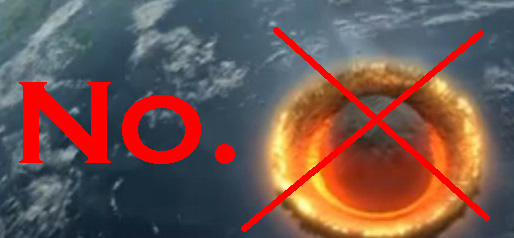
[*Correction: This article originally listed Feb. 15 as a Saturday instead of Friday. There was also a typo in the headline, referring to the asteroid as DA15. That too has been corrected.]
Watch Bad Astronomy blogger Phil Plait discuss the near-Earth asteroid in a Google Hangout:

